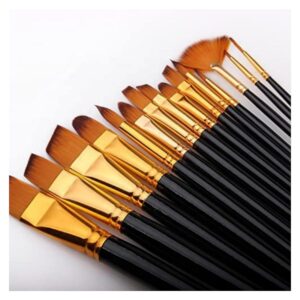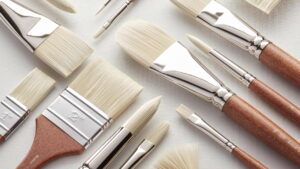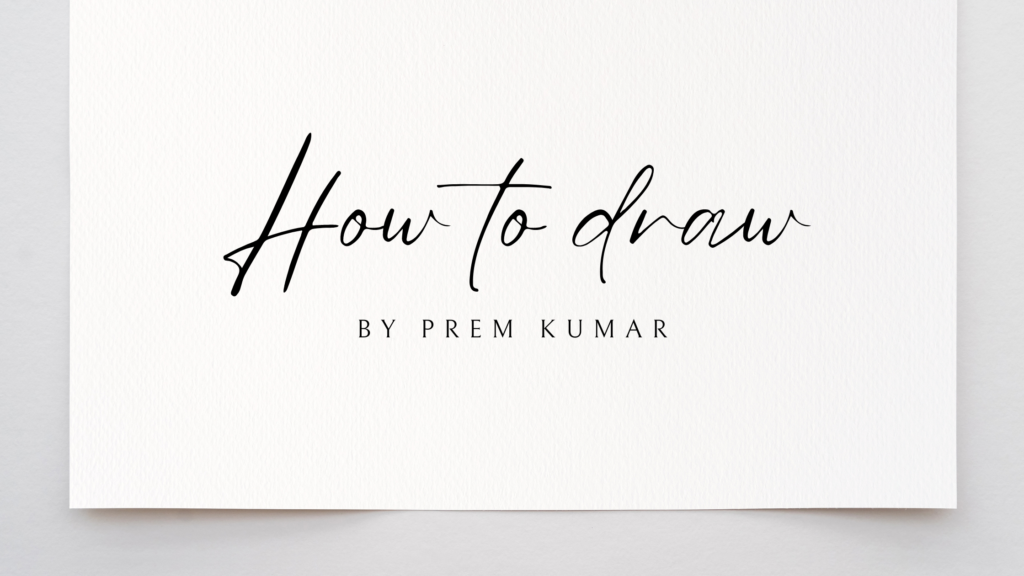As an artist with a decade of experience, I’ve learned the importance of brush selection in the outcome of an acrylic painting. Acrylics, known for their versatility, vibrant colors, and quick drying time, necessitate a careful brush selection to bring out the best in your artistic vision. In this article, we’ll delve into the diverse world of acrylic paint brushes, looking at the best types for different techniques that can take your artwork to new heights.

Brush Forms and Sizes
Let’s start with the fundamental shapes and sizes of acrylic paint brushes before delving into specific techniques. Each shape serves a specific purpose, and selecting the right one can have a significant impact on the texture and style of your artwork.
1. Round Brushes: With a pointed tip, these brushes are ideal for intricate details, fine lines, and controlled strokes. They are available in a variety of sizes, with smaller rounds ideal for delicate work and larger rounds ideal for broad strokes.
2. Flat Brushes: Flat brushes with a square end are great for bold strokes, washes, and covering large areas. They are available in both short and long bristle lengths, each providing a unique painting experience.
3. Filbert Brushes: Filbert brushes have a rounded, flat end that combines the characteristics of round and flat brushes. They are popular among artists because they are versatile and can be used for fine details as well as broad strokes.
4. Bright Brushes: Bright brushes, like flat brushes but with shorter bristles, are excellent for short, controlled strokes and details. They’re especially useful when you need to be precise with your work.
5. Angular Brushes: These brushes have a slanted or angled edge and are ideal for creating sharp, angular strokes. They can be used for fine lines as well as broader strokes.

Recognizing the Surface
Different surfaces necessitate the use of different brushes to achieve the desired effect. Whether you’re working on canvas, paper, wood, or fabric, selecting the right brush is essential.
1. Canvas: When painting on canvas, consider using a combination of flat and filbert brushes. Flat brushes efficiently cover large areas, whereas filbert brushes allow for more controlled blending and detailing.
2. Paper: Use softer brushes when working on paper to avoid damaging the surface. Round brushes are great for detailed work on paper, while flat brushes are great for washes.
3. Wood: To ensure proper coverage, use brushes with stiffer bristles when painting on wood. Flat brushes are ideal for covering larger wooden surfaces, whereas round brushes are ideal for fine details.
4. Fabric: If you want to paint on fabric, use brushes made specifically for textiles. Soft synthetic bristle brushes work well on fabric, allowing for smooth application without damaging the fibers.

Techniques and Matching Brushes
Let’s look at some acrylic painting techniques and the brushes that go with them.
1. Blending: – Technique: A hallmark of acrylic painting is the seamless blend of colors. Consider using soft, synthetic brushes with rounded tips for this. Filbert brushes, in particular, excel at smoothly blending colors, allowing for a smooth transition between shades.
2. Impasto: – Impasto is a technique in which thick layers of paint are applied to create a textured, three-dimensional effect. Use flat or filbert brushes with strong bristles for this technique. Because of the thickness of these brushes, you can apply paint more liberally, resulting in the desired impasto texture.
3. Fine Detailing: – Technique: Use round brushes when working on intricate details such as small patterns or delicate features. The pointed tips of round brushes provide precision and control, allowing you to easily add fine details.
4. Drybrush Technique: – Dry brushing is a technique that involves using a dry brush with little paint to create a textured, scratchy effect. For this technique, use flat or bright brushes with short bristles. Because the brush is dry, only the raised areas of the canvas catch the paint, creating a distinct texture.
5. Washes: – Technique: For smooth washes, use brushes with soft, long bristles. Flat brushes are the preferred tool for achieving even and consistent washes. These brushes’ large surface area allows for quick coverage while maintaining a fluid application.
Conclusion
Choosing the right brushes for acrylic painting is akin to selecting the perfect tools for a craft. Each brush type serves a specific purpose, and understanding their characteristics can help you improve your artistic abilities significantly. Whether you want to create fine details, bold strokes, or textured effects, the right brush is the key to unleashing your creativity. Experiment with different brush shapes and sizes, think about the surface you’re working on and enjoy the variety of techniques that acrylics provide. Acrylic paintings are bound to reach new levels of expression and beauty with the right knowledge and the right brushes in hand.
Some Best Brushes For Artist:
1. Sabahz Trading Round Pointed Tip Artist Paint Brushes – Link
2. ARTIOS Flat Paint Brushes – Link
3. ARTIOS Filbert Paint Brushes – Link
4. ARTIOS Angular Paint Brushes – Link
Read Also:- Understanding Brush Bristles: Natural vs. Synthetic Fibers
To learn more about art, visit SILPAVAT.IN


